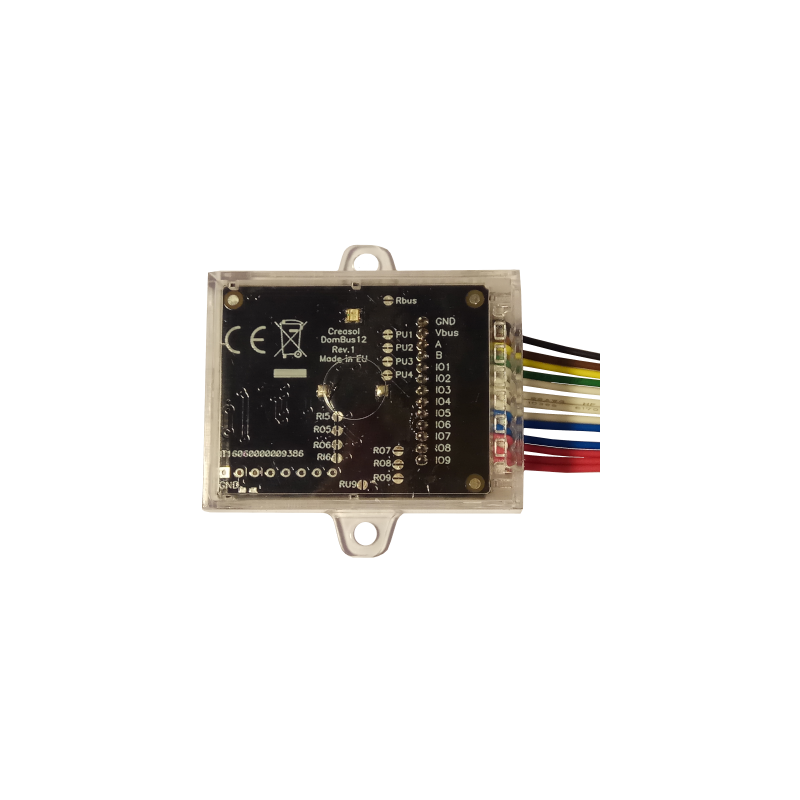

Email: store@creasol.it - Telegram: CreasolTech - Whatsapp: +393283730010
Priority mail: snel en goedkoop - Express Courie
Neem contact met ons op voordat u producten retourneert!

Creasol DomBus12 is een compacte module40x30x11mm,met 9 configureerbare in- / uitgangen
Het kan worden aangesloten op de Domoticz-controller via een RS485 seriële bus (4 draden, 2 voor 12 / 24V-voeding en 2 voor gegevens op 115200bps).
Net als andere DomBus-apparaten,DomBus12 is ontworpen om een laag stroomverbruik te verbruiken, betrouwbaar, volledig configureerbaar en gebruiksvriendelijk te zijn
 Volledige ondersteuning: de meeste producten zijn door ons ontworpen!
Volledige ondersteuning: de meeste producten zijn door ons ontworpen!
Email: store@creasol.it - Telegram: CreasolTech - Whatsapp: +393283730010
 Bestellingen worden binnen 1 werkdag verzonden
Bestellingen worden binnen 1 werkdag verzonden
Priority mail: snel en goedkoop - Express Courie
 24 maanden garantie, eenvoudig retourneren/restitueren
24 maanden garantie, eenvoudig retourneren/restitueren
Neem contact met ons op voordat u producten retourneert!
Creasol DomBus12 is een compacte module40x30x11mm,met 9 configureerbare in- / uitgangen
Het kan worden aangesloten op de Domoticz-controller via een RS485 seriële bus (4 draden, 2 voor 12 / 24V-voeding en 2 voor gegevens op 115200bps).
Net als andere DomBus-apparaten,DomBus12 is ontworpen om een laag stroomverbruik te verbruiken, betrouwbaar, volledig configureerbaar en gebruiksvriendelijk te zijn


/ p>

Standaardadres: 0xff12
| Haven# | Naam | Mogelijkheden | Standaard configuratie | Beschrijving |
| 1 | IO | IN_DIGITAL, IN_ANALOG, IN_TWINBUTTON, IN_COUNTER, OUT_DIGITAL | IN_TWINBUTTON | Input, met optionele pullup (pcb-jumper) |
| 2 | IO2 | IN_DIGITAL, IN_ANALOG, IN_TWINBUTTON, IN_COUNTER, OUT_DIGITAL | IN_TWINBUTTON | Input, met optionele pullup (pcb-jumper) |
| 3 | IO3 | IN_DIGITAL, IN_ANALOG, IN_TWINBUTTON, IN_COUNTER, OUT_DIGITAL | IN_TWINBUTTON | Input, met optionele pullup (pcb-jumper) |
| 4 | IO4 | IN_DIGITAL,IN_ANALOG, IN_TWINBUTTON, IN_COUNTER, OUT_DIGITAL | IN_TWINBUTTON |
Input, met optionele pullup (pcb-jumper) |
| 5 | IO5 | IN_DIGITAL, IN_ANALOG, OUT_DIGITAL, OUT_RELAY_LP, OUT_BLIND, OUT_DIMMER | OUT_DIGITAL | Open-drain output, 60V 100mA capaciteit, geschikt om aangesloten te worden op een extern relais. Met 2 pcb jumpers is het mogelijk om mosfet te omzeilen en deze poort als normale input / output te gebruiken. |
| 6 | IO6 | IN_DIGITAL, IN_ANALOG, OUT_DIGITAL, OUT_RELAY_LP, OUT_BLIND, OUT_DIMMER | OUT_DIGITAL | Open-drain output, 60V 100mA capaciteit, geschikt om aangesloten te worden op een extern relais. Met 2 pcb jumpers is het mogelijk om mosfet te omzeilen en deze poort als normale input / output te gebruiken. |
| 7 | IO7 | IN_DIGITAL, IN_ANALOG, IN_COUNTER, OUT_DIGITAL, OUT_BLIND, OUT_DIMMER td> | IN_DIGITAL | Ingang, met optionele weerstand van 150 ohm die kan worden ingeschakeld door een pcb-jumper om een externe zoemer of relaiskaart in relaisstuurprogramma aan te sturen |
| 8 | IO8 | IN_DIGITAL, IN_ANALOG, IN_COUNTER, OUT_DIGITAL, OUT_BLIND, OUT_DIMMER, OUT_BUZZER td> | IN_DIGITAL | Ingang, met optionele weerstand van 150 ohm die kan worden ingeschakeld door een pcb-jumper om een externe zoemer of relaiskaart in relaisstuurprogramma aan te sturen |
| 9 | IO9 | IN_DIGITAL, IN_ANALOG, IN_COUNTER, OUT_DIGITAL, OUT_BLIND, OUT_DIMMER, OUT_BUZZER td> | IN_DIGITAL | Input, with optionele weerstand van 150 ohm die kan worden ingeschakeld door een pcb-jumper om een externe zoemer of relaiskaart in relaisstuurprogramma aan te sturen |
(1): kan worden gebruikt als BLIND-uitgang, om een jaloezie / gordijn te openen, maar alleen de vorige poort kan in Domoticz worden geconfigureerd als OUT_BLIND omdat, wanneer geconfigureerd als OUT_BLIND, het DomBus-apparaat automatisch de volgende poort configureert om een relais in open richting.
Sluit gewoon de twee open-drain-uitgangen aan op de 2-relaismodule met een willekeurig type kabel (bijvoorbeeld een standaard 4x0,22mm²). p>
Deze uitgangen kunnen worden geconfigureerd als OUT_DIGITAL of, beter, als OUT_RELAY_LP: in dit geval zal het stroomverbruik van het relais 1/3 of minder zijn.
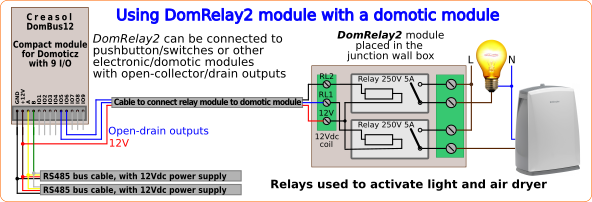
 Veel energiemeters, zoals Eastron SDM230, bieden 2 pulsuitgangen om de import en export van energie te tellen, 1 puls per Wh.
Veel energiemeters, zoals Eastron SDM230, bieden 2 pulsuitgangen om de import en export van energie te tellen, 1 puls per Wh.
Met DomBus12, DomBus23 of DomBusTH is het heel gemakkelijk om de pulsen van energiemeters af te lezen, het onmiddellijke vermogen te berekenen en twee apparaten in Domoticz te krijgen die het u tonensalie en retourvermogen, verbruik en totale retourenergie en grafieken. Hieronder de instructies wanneer SDM230 wordt gebruikt (maar kijk in de handleiding van je energiemeter om deze aan te sluiten):
 opgewekte energie moet worden gemeten, configureer het Domoticz-apparaat dat is aangesloten op Pulse1 zoals eerder: druk op Bewerken op dat apparaat en vervang in het veld Beschrijving IN_DIGITAL of IN_TWINBUTTON door
opgewekte energie moet worden gemeten, configureer het Domoticz-apparaat dat is aangesloten op Pulse1 zoals eerder: druk op Bewerken op dat apparaat en vervang in het veld Beschrijving IN_DIGITAL of IN_TWINBUTTON doorDomoticz heeft tot 5 minuten nodig om de energieteller correct te updaten.
Water- en gasmeter hebben doorgaans een opto-geïsoleerde uitgang die elke 0.NNN m³ een puls genereert.
Door die uitgang aan te sluiten op een I / O-ingang van DomBus12, of DomBus23 of DomBusTH, en een gemeenschappelijke uitgang op GND, is het mogelijk om een incrementele teller in Domoticz te krijgen die water, gas,en al het andere: tegendeler, meteroffset en maateenheid kunnen worden gespecificeerd in Domoticz.
Het I / O-apparaat dat op de meter is aangesloten, moet op deze manier worden geconfigureerd: klik op Bewerken op het domoticz-apparaat, schrijf de juiste naam (bijvoorbeeld Water_Meter), vervang het huidige apparaattype (bijvoorbeeld IN_DIGITAL) in het veld Beschrijving doorIN_COUNTERen opslaan: het apparaat wordt verplaatst naar het Utility-paneel en is klaar om pulsen te tellen.
Het volgende schema laat zien hoe u deze domotica-module kunt gebruiken om enkele alarmsensoren te bedienen (PIR, om bewegingen in een kamer te detecteren, en 4 magnetische contactsensoren toegepast op ramen, deuren en jaloezieën, om de open toestand en overgang te detecteren), en ook commando 2 belastingen (licht en ontvochtiger, bijvoorbeeld) door gebruik te maken van de extra DomRelay2-kaart (binnen 2 relais) geplaatst nabij de belastingen en verbonden met DomBus12 door een kleine draadkabel.
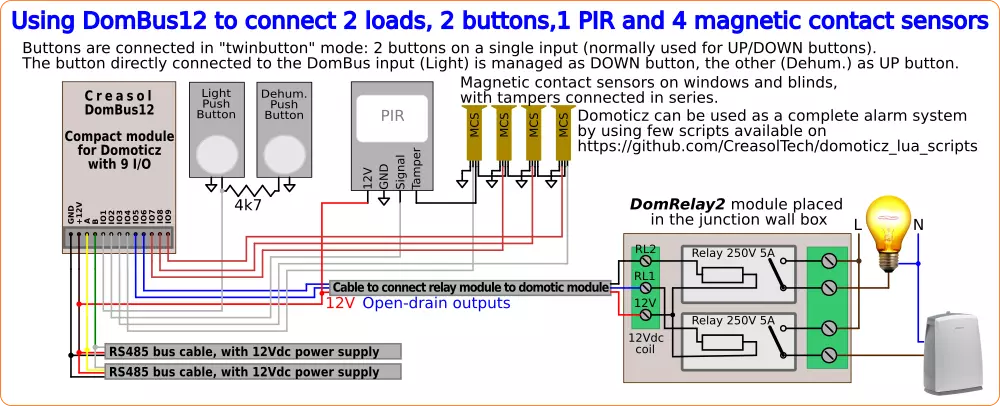
Zowel DomBus12 als DomRelay2 zijn zeer kleine modules die overal passen.
De twee knoppen zijn met elkaar verbonden door een 4k7-weerstand en verbonden met een enkele ingangsdraad: deze configuratie wordt "dubbele knop"enmaakt het mogelijk om 2 knoppen te gebruiken voor elke module-ingang, en wordt normaal gesproken gebruikt door dubbele knoppen met de functie OMHOOG / OMLAAG (bijvoorbeeld van toepassing op rolluiken) of AAN / UIT.
DomBus12, DomBus23, DomBus31 en DomBusTH hebben ook de mogelijkheid om commando's rechtstreeks naar andere apparaten te sturenvan dezelfde familie (en ook voor zichzelf), met de volgende voordelen:
Voorbeeld: moduleadres = 1201, met 2 knoppen aangesloten op poort 1 en geconfigureerd alsIN_TWINBUTTON, met de volgende functies:
Korte puls op de OMLAAG-knop om het licht (aangesloten op poort 6 van module 1201) 120 seconden AAN te zetten:DCMD (puls) = 1201.6: AAN: 120s
2s puls op DOWN-knop om hetzelfde licht AAN / UIT te schakelen zonder enige timer:DCMD (Pulse2) = 1201.6: WISSELEN
Korte puls op de UP-knop om de luchtontvochtiger (aangesloten op poort 5 van module 1201) 2 uur AAN te zetten:DCMD (puls) = 1201.5: AAN: 2 uur
1s pulsom de luchtontvochtiger UIT te schakelen:DCMD (Pulse1) = 1201.5: UIT
Om poort 1 van module 1201 op deze manier te configureren, is het voldoende om het poort 1-apparaat in Domoticz te bewerken en in de beschrijving alle bovenstaande commando's te schrijven:
IN_TWINBUTTON, DCMD (puls) = 1201.6: AAN: 120s, DCMD (puls2) = 1201.6: WISSELEN, DCMD (puls) = 1201.5: AAN: 2 uur, DCMD (puls1) = 1201.5: UIT
Dan werken licht en ontvochtiger ook als Domoticz offline is.
MEER INFORMATIE OPhttps://www.creasol.it/CreasolDomBus12
The following video shows a presentation of some domotic modules designed and produced in Italy by Creasol to make a reliable, easy and power-optimized home automation system.
The next video shows our Smart EVSE module that can be used to charge the electric car by using only solar power, or adding 25/50/75/100% of available power from the electrical grid.
Our industrial and home automation modules are designed to be
Modules are available in two version:

Store website - Information website
For our products we can offer FULL SUPPORT and CUSTOMIZATION: please contact us by Email or Telegram
 Complete solution to make a Smart EVSE, charging the electric vehicle using only energy from renewable source (photovoltaic, wind, ...), or adding 25-50-75-100% of available power from the grid.
Complete solution to make a Smart EVSE, charging the electric vehicle using only energy from renewable source (photovoltaic, wind, ...), or adding 25-50-75-100% of available power from the grid.
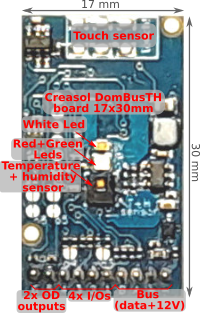 Compact board, 32x17mm, to be installed on blank cover with a 4mm hole in the middle, to exchange air for the relative humidity sensor. It can be installed in every room to monitor temperature and humidity, check alarm sensors, control blind motor UP/DOWN, send notifications (using red and green leds) and activate white led in case of power outage.
Compact board, 32x17mm, to be installed on blank cover with a 4mm hole in the middle, to exchange air for the relative humidity sensor. It can be installed in every room to monitor temperature and humidity, check alarm sensors, control blind motor UP/DOWN, send notifications (using red and green leds) and activate white led in case of power outage.
Includes:
 Very compact, versatile and cost-effective module with 9 ports. Each port can be configured by software as:
Very compact, versatile and cost-effective module with 9 ports. Each port can be configured by software as:
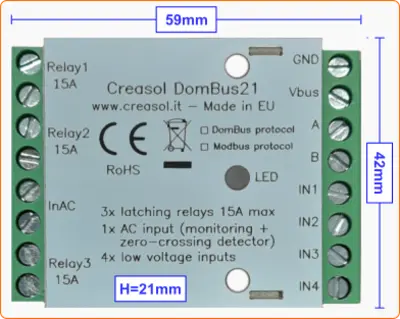 Very low power consumption module designed to enable up to 3 high power loads, up to 15A (3kW).
Very low power consumption module designed to enable up to 3 high power loads, up to 15A (3kW).
 Versatile module designed to control gate or garage door.
Versatile module designed to control gate or garage door.
 DIN rail low profile module, with 8 relays and very low power consumption:
DIN rail low profile module, with 8 relays and very low power consumption:
 Versatile module with 230V inputs and outputs, and 5 low voltage I/Os.
Versatile module with 230V inputs and outputs, and 5 low voltage I/Os.
 Module designed to control 3 lights already existing and actually controlled by 230V pushbuttons and step-by-step relays. In this way each light can be activated by existing pushbuttons, and by the domotic controller.
Module designed to control 3 lights already existing and actually controlled by 230V pushbuttons and step-by-step relays. In this way each light can be activated by existing pushbuttons, and by the domotic controller.
Each relay can toggle the existing step-relay, switching the light On/Off. The optoisolator monitors the light status. The 5 I/Os can be connected to pushbuttons to activate or deactivate one or all lights.
 DIN rail module, low profile, with 12 relays outputs and very low power consumption.
DIN rail module, low profile, with 12 relays outputs and very low power consumption.
 Module designed to be connected to alarm sensors (magnetc contact sensors, PIRs, tampers): it's able to monitor mains power supply (power outage / blackout) and also have 3 relays outputs.
Module designed to be connected to alarm sensors (magnetc contact sensors, PIRs, tampers): it's able to monitor mains power supply (power outage / blackout) and also have 3 relays outputs.
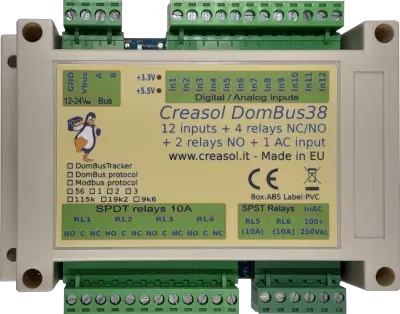 DIN rail module designed for burglar alarm system.
DIN rail module designed for burglar alarm system.
![]() DIN rail module that control azimuth + elevation/tilt motors of a sun tracker, to maximize photovoltaic energy production during the day and seasons.
DIN rail module that control azimuth + elevation/tilt motors of a sun tracker, to maximize photovoltaic energy production during the day and seasons.
 Simple module with 2 relays, to be used with DomBus modules or other electronic boards with open-collector or open-drain outputs
Simple module with 2 relays, to be used with DomBus modules or other electronic boards with open-collector or open-drain outputs
 IoT board designed for NodeMCU v3 board using ESP8266 WiFi microcontroller
IoT board designed for NodeMCU v3 board using ESP8266 WiFi microcontroller